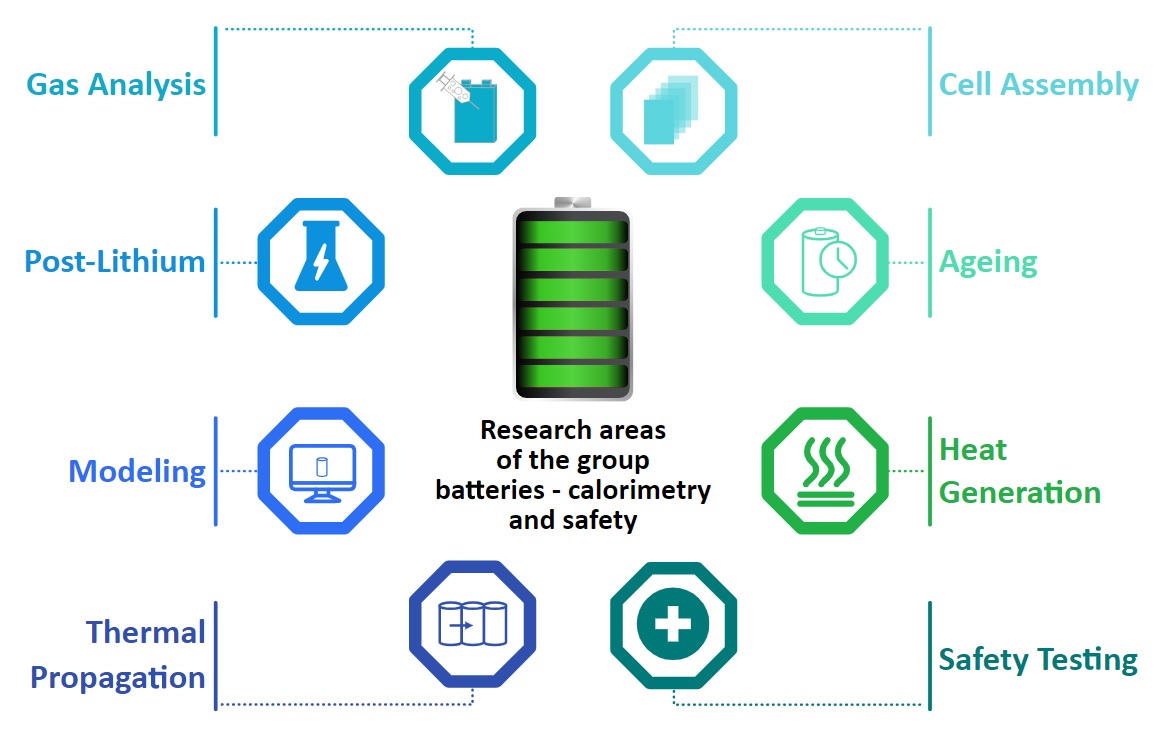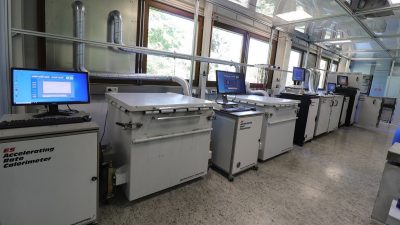The Calorimeter Center uses calorimeters to advance thermal management and safety of batteries, handling thermodynamic, thermal and safety data
Safety comes first – this is the mission of the Center’s head, Dr. Carlos Ziebert at the Institute for Applied Materials – Applied Materials Physics (IAM-AWP) of Karlsruhe Institute of Technology (KIT), outlining how research and testing in calorimeters is crucial to improve the performance and safety of batteries.
Importance of safe batteries
Established in 2011 the Calorimeter Center at the Karlsruhe Institute of Technology’s (KIT) Institute for Applied Materials – Applied Materials Physics, operates Europe’s largest Battery Calorimeter Laboratory. It provides seven Accelerating Rate Calorimeters (ARCs) of different sizes – from coin to large pouch or prismatic automotive format – which allow the evaluation of thermodynamic, thermal and safety data for Lithium-ion cells on material, cell and pack level under quasiadiabatic and isoperibolic environments for both normal and abuse conditions (thermal, electrical, mechanical).
Dr. Ziebert also leads the group “Batteries – Calorimetry and Safety”. The group is interdisciplinary, well networked across Germany and internationally, and takes a comprehensive approach ranging from fundamental studies to industrial applications. Since the center was founded, more than 200 thermal studies and safety tests have been performed at the ARCs on cells ranging from coin cell size to cylindrical cells to pouch and large prismatic automotive cells. As a result, this method has become so well established at the IAM-AWP that it is now one of the leading international institutions in the field of thermal runaway investigations, as reflected in numerous industrial contracts and invited lectures. The research areas of the group “Batteries – Calorimetry and Safety” focus on the investigation of the safety of lithium-ion cells as well as post-lithium cells. In particular, calorimetric methods are used to take an in-depth look at a wide range of aspects of their safety and thermal properties.

 The development of safe Lithium-ion cells is of the utmost importance for a breakthrough in the electrification of transport and for stationary storage, because an uncontrollable increase in temperature of the entire system (so-called ‘thermal runaway’) can cause an ignition or even explosion of the battery with simultaneous release of toxic gases. Thermal runaway is a worst case scenario, that has to be avoided under all circumstances, especially in an electric car or another electric vehicle, and the causes and effects of this can be very diverse and complex. As such, it is crucial to conduct thermodynamic studies of the thermal effects together with the material and cell development for advanced and even post-Lithium systems. In the current state of the Lithium-ion technology the range of properties is still significantly dependent on the respective operating and usage conditions (state of charge, age) as well as the ambient conditions. The influence of ageing on the safety of the cells is a very critical factor for their commercial use. Even the regular use of batteries with varying charge and discharge cycles under different operating and environmental conditions leads to the release of heat and sometimes critical temperature increases in the system. These effects are caused by electrochemical reactions, phase transformations, mixing and joule heating processes. The active materials can initiate highly exothermic reactions in dependence on the respective battery operating conditions and the ambient temperature by internal and external short circuit or by mechanical action. This can be followed by the thermal runaway. To avoid such reactions, the system must be designed optimally with respect to the material and cell level. In addition, the battery management and cooling systems must be optimised for the technical requirements. Thus, the complete scientific and technical understanding of these effects is essential.
The development of safe Lithium-ion cells is of the utmost importance for a breakthrough in the electrification of transport and for stationary storage, because an uncontrollable increase in temperature of the entire system (so-called ‘thermal runaway’) can cause an ignition or even explosion of the battery with simultaneous release of toxic gases. Thermal runaway is a worst case scenario, that has to be avoided under all circumstances, especially in an electric car or another electric vehicle, and the causes and effects of this can be very diverse and complex. As such, it is crucial to conduct thermodynamic studies of the thermal effects together with the material and cell development for advanced and even post-Lithium systems. In the current state of the Lithium-ion technology the range of properties is still significantly dependent on the respective operating and usage conditions (state of charge, age) as well as the ambient conditions. The influence of ageing on the safety of the cells is a very critical factor for their commercial use. Even the regular use of batteries with varying charge and discharge cycles under different operating and environmental conditions leads to the release of heat and sometimes critical temperature increases in the system. These effects are caused by electrochemical reactions, phase transformations, mixing and joule heating processes. The active materials can initiate highly exothermic reactions in dependence on the respective battery operating conditions and the ambient temperature by internal and external short circuit or by mechanical action. This can be followed by the thermal runaway. To avoid such reactions, the system must be designed optimally with respect to the material and cell level. In addition, the battery management and cooling systems must be optimised for the technical requirements. Thus, the complete scientific and technical understanding of these effects is essential.
Calorimetry is very important as it is fundamental to obtain quantitative data on the thermal behaviour. This information can then be used to adapt the battery and thermal management systems. Our sophisticated battery calorimetry allows finding new and quantitative correlations between different critical safety and thermally related parameters. In addition our established differential scanning calorimeters (DSC), thermogravimetric analyzers (TGA), laser flash analyzers (LFA) and extremely sensible Tian-Calvet calorimeters can provide thermodynamic parameters such as heat capacity, thermal conductivity or formation enthalpy on the materials level. With all these facilities, and the established technical and methodological expertise, the IAM-AWP is now – seen worldwide – one of the few institutions that investigate both the thermodynamics and the safety of batteries and their materials.


